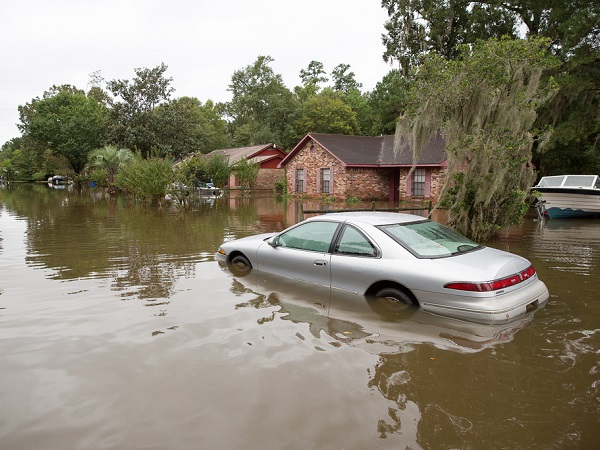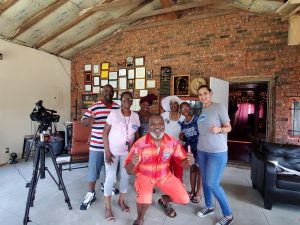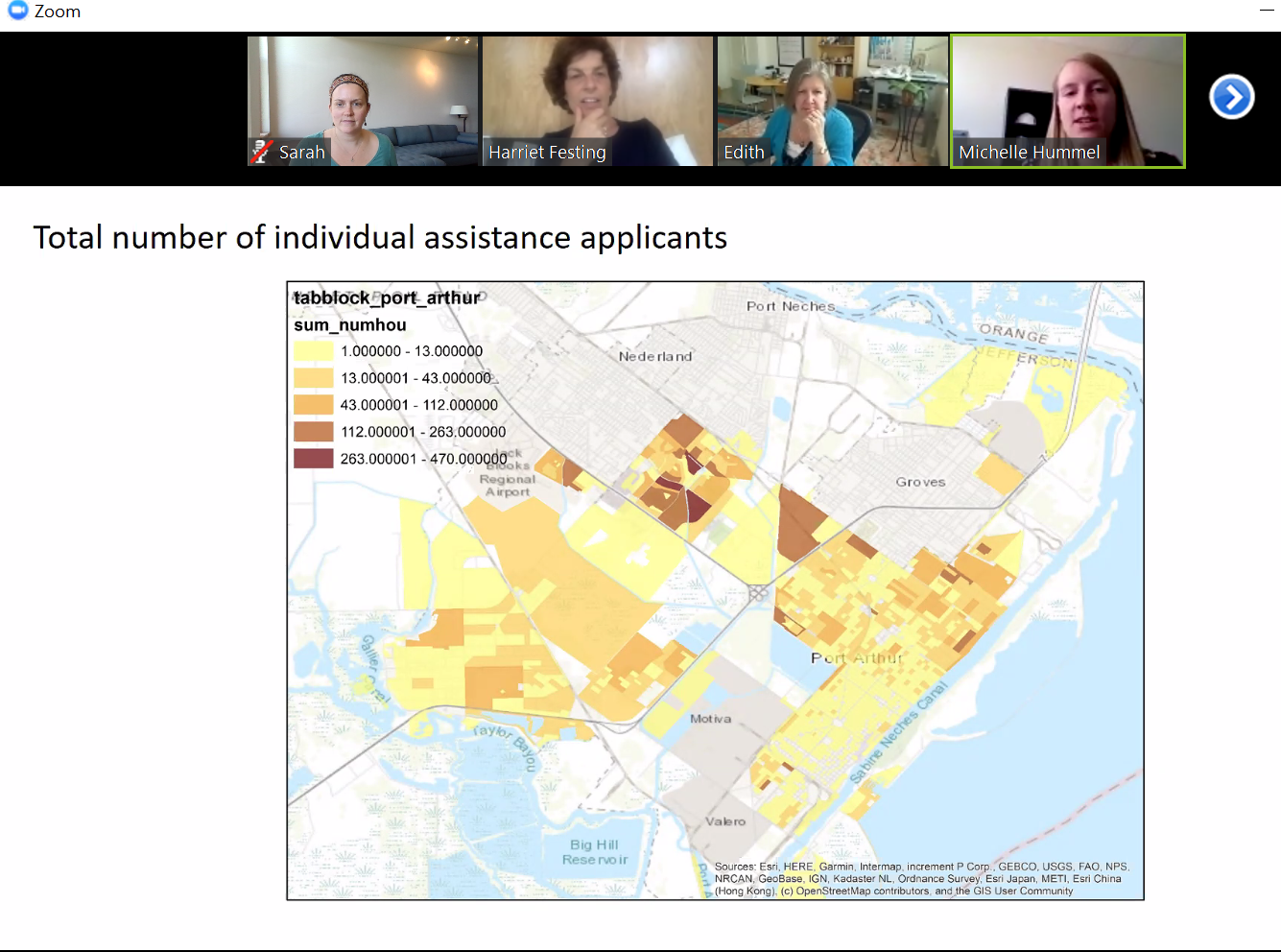Apply now to join our next cohort of Community Science Fellows and Community Leads!

The Team
Michelle Hummel, Department of Civil Engineering at the University of Texas at Arlington, [email protected]
Harriet Festing, Anthropocene Alliance, [email protected]
Edith Wilson, Rock Whisperer LLC, [email protected]
April O’Leary, Horry County Rising, Horry County, SC [email protected]
Susan Liley, Citizen’s Committee for Flood Relief, De Soto, MO [email protected]
Hilton Kelley, Community In Power and Development Association, Port Arthur, TX
Melissa Krupa, Horry County, SC
Denise Ross, Lemmon Valley/Swan Lake Recovery Community Committee, Lemmon Valley, NV
Results
The focus of this Higher Ground mapping pilot project was to identify mapping tools and datasets that could be applied across four communities with Higher Ground flood groups: Port Arthur, TX, Lemmon Valley, NV, Desoto, MO, and Horry County, SC. The goal was to find a replicable and rapid way of mapping flood risks in these communities. Flood risk maps were generated for all communities, but only two of the communities, Port Arthur, TX, and Horry County, SC, plan to use these maps to lead a buyout/flood proofing campaign with residents. Reasons for this are explained, below. The flood maps then informed the communities on which neighborhoods to target survey/canvass efforts for property buyouts and/or flood proofing efforts.

Hilton Kelley (front, center) with members of CIDA-Inc rallying for a flood meeting in Port Arthur, TX.
Dr. Michelle Hummel worked with Harriet Festing to collect and collate historical flood data from FEMA and socioeconomic/demographic data from the Census Bureau. Dr. Hummel then incorporated this data into a spatial data analysis and mapping framework to identify potentially disadvantaged neighborhoods impacted by the flooding that might be good candidates for buyouts or flood proofing. Data sets included several types of FEMA data, such as Severe Repetitive Loss Property data aggregated at the zip code level (obtained from the Natural Resources Defense Council), National Flood Insurance Program (NFIP) claims data aggregated at the Census tract level, and Individual Assistance claims data aggregated at the Census block level. The team also obtained digital elevation data from the U.S. Geological Survey’s National Map. Finally, the team aggregated and analyzed this data using Python and developed corresponding maps using ArcGIS. Individual Assistance claims were only available for Port Arthur, TX. Repetitive Loss and NFIP data were available for all communities.
Dr. Hummel and Harriet met with the full team on a few occasions to review the maps together and begin to outline a strategy for surveying residents on buyouts, using the maps as a foundation. Harriet also created a grid to outline the information that was needed to accelerate a conversation on a buyout program.
Project Outputs:
Project Impacts:
Reflections
The team is eager to see if the community surveys lead to resident-led buyout programs. Understanding the outcome of these canvassing efforts will help the team determine whether the methodology and process is worth replicating in other Higher Ground communities. This project laid the groundwork for other communities to adopt a similar mapping exercise when considering a buyout program.
From this project, others may learn better ways to partner with Thriving Earth Exchange for their own purposes. For instance,
The team noted that the following contributed to the success of the project:
However, there were a few key things that the team would do differently if they had the chance to do this project again:
To other teams currently pursuing Thriving Earth Exchange projects and for those that anticipate doing a Thriving Earth Exchange project, the team recommends:
The environmental crisis is global, but its impacts are felt locally, especially in low income and minority communities. Anthropocene Alliance (Aa) is a Florida-based non-profit organization that assists vulnerable communities across the U.S. who have been harmed by environmental abuse and climate change. Aa does this by building grassroots coalitions in the communities most badly affected. Aa provides support and training to community leaders and connects them to the government agencies and nonprofit programs that can help them the most.
Because these leaders know more about the harms they suffer than we do, and because they often possess great creativity and resilience, they are essential partners for us in the search for practical policy solutions to our most pressing, environmental challenges. Low-income communities, particularly ones that have been historically marginalized — Black, Latino and Native American — are both more vulnerable to flooding and less likely to have access to the information and technology they need.
Aa’s Higher Ground is the largest flood survivor group in the U.S. They are currently working with 40 flood survivor groups in 19 U.S. states. The groups are urban and rural, coastal and inland. They are affected by coastal, riverine and overland flooding. Higher Ground is designed to help the group leaders and their communities through the entire process, from diagnosing the problem using the best, new data and technology available, to identifying solutions such as home buyouts, elevation and green infrastructure solutions. This will be accomplished through an integrated toolkit, comprised of initial meetings, intense discussions, distribution of surveys and factsheets, organization of community events, consultation with technology partners, and most of all, the application of a set of analytical and scientific instruments that will help residents make a persuasive case to the local, state and federal agencies that command the resources.
This project involves risk mapping in select communities across the United States to help residents understand their flood risks and identify properties for potential buyouts or elevation of structures.
This project engages communities already paired with Thriving Earth Exchange hydrologists across the United States:

June 7, 2019
Together on a Zoom call on Friday, June 7th, the Higher Ground communities and Thriving Earth Exchange team came together to discuss initial map outputs from the mapping work Michelle Hummel is doing across four U.S. communities. Michelle shared some initial maps using individual assistance claims data from FEMA for Port Arthur, TX. Drawing on connections with Fair Share Housing, Natural Resources Defense Council (NRDC), and Illinois Department of Natural Resources, the team is preparing maps that draw on individual assistance claim data, digital elevation models (DEMs), LiDAR data, and repetitive loss data.
Science Liaison

Michelle Hummel is an Assistant Professor of Water Resources in the Department of Civil Engineering at the University of Texas at Arlington. She specializes in the development of numerical models to simulate flood hazards driven by extreme events and long-term sea-level rise and uses these models to quantify impacts on populations and critical infrastructure systems. She has previously studied regional patterns of flood exposure due to sea-level rise in the San Francisco Bay Area, considering community-level demographics and infrastructure dependencies. Michelle holds a Ph.D. in Environmental Engineering from the University of California, Berkeley.

(c) 2024 Thriving Earth Exchange